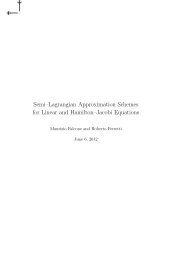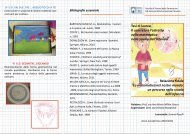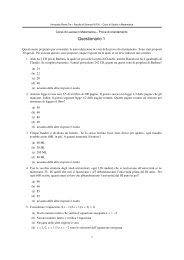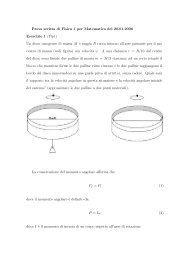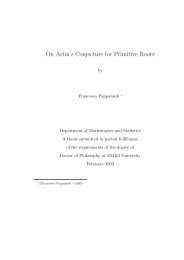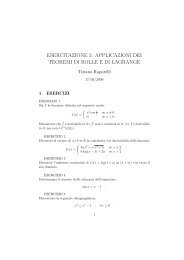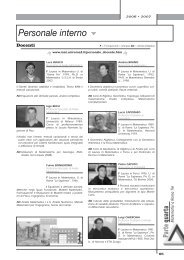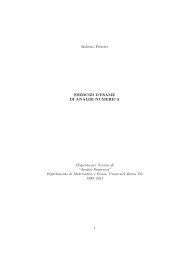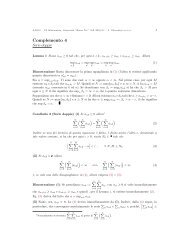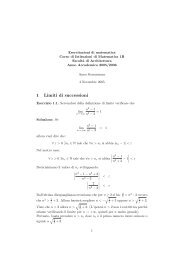esercitazione 10: integrali definiti, polinomio di taylor e teorema di ...
esercitazione 10: integrali definiti, polinomio di taylor e teorema di ...
esercitazione 10: integrali definiti, polinomio di taylor e teorema di ...
You also want an ePaper? Increase the reach of your titles
YUMPU automatically turns print PDFs into web optimized ePapers that Google loves.
e l’intersezione con f(x), per x > 0, è la soluzione (positiva) del sistema<br />
√<br />
1 − x 2 = √ x<br />
cioè è il punto a = −1+√ 5<br />
2<br />
. Poiché entrambe le funzioni sono pari, l’area<br />
cercata è pari a<br />
A(S) = 2<br />
∫ a<br />
= | x=sin t 2 (∫ arcsin a<br />
Dunque l’area della regione cercata è<br />
=<br />
0<br />
0<br />
(√<br />
1 − x 2 − √ x ) dx<br />
cos 2 tdt − 2 3 x 3<br />
2 ∣ a )<br />
0<br />
[<br />
sin t cos t + t<br />
] arcsin a<br />
0<br />
− 4 3 a 3 2<br />
= 2a cos(arcsin a) + arcsin a − 4 3 a 3 2<br />
= 2a √ 1 − a 2 + arcsin a − 4 3 a 3 2 .<br />
A(R) = π − A(S) .<br />
ESERCIZIO 2<br />
(a) È una forma indeterminata del tipo [ 0<br />
0]<br />
, applichiamo il <strong>teorema</strong> fondamentale<br />
del calcolo integrale e il <strong>teorema</strong> <strong>di</strong> De l’Hopital:<br />
lim<br />
x→0<br />
(b) Come nel caso (a) ,<br />
∫<br />
1 x<br />
e x2 − 1<br />
x 3 (e t2 − 1)dt = lim<br />
x→0 3x 2 = 1 3<br />
0<br />
.<br />
lim<br />
x→0<br />
∫<br />
1 x 2<br />
log(1 + sin x 2 )2x<br />
x 4 log(1 + sin t)dt = lim<br />
0<br />
x→0 4x 3<br />
log(1 + sin x 2 ) 2x sin x 2<br />
= lim<br />
x→0 sin x 2 4x 3 = 1 2<br />
(c) Forma indeterminata [1 ∞ ]<br />
sin x 1<br />
cos 2 x = e 1<br />
cos 2 x log(sin x) ,<br />
.<br />
e<br />
lim<br />
x→ π 2<br />
1<br />
cos 2 x log(sin x) = [0 0 ] .<br />
4



